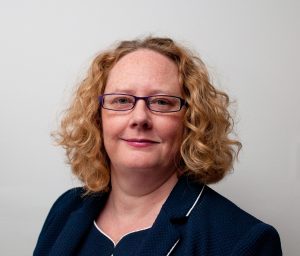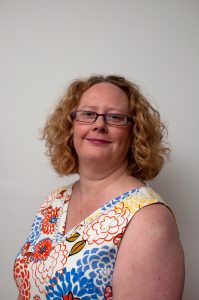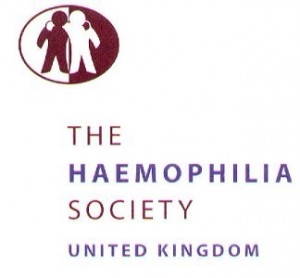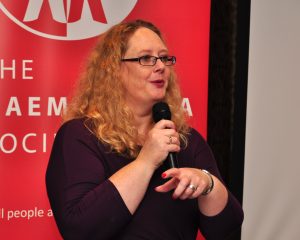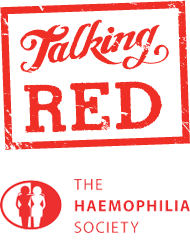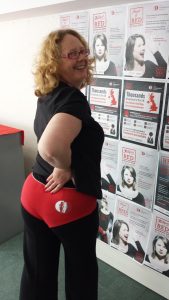Interview – Liz Carroll
Liz Carroll
Liz Carroll, Chief Executive of the UK Haemophilia Society is responsible for leading the charity ensuring we provide quality services driven by what our members need, and sustaining our work for the years to come.
www.haemophilia.org.uk
Would you please tell us your job title and how long you have been doing this?
I’m the Chief Executive of the Haemophilia Society and I have been here 2.5 years now.
What career did you wish to pursue before leaving school?
I only ever wanted to be a nurse, from a young as I can remember!
How did you come to work in this particular organisation?
I did train to be a nurse, training At St Bartholomew’s Hospital in London (The best possible place to train!) and worked at Barts and the London for several years, mainly in cancer care. I then moved on to work on the Helpline at CancerBACUP, spending 7 years there working on patient information and setting up the very first cancer information centres in hospitals that are now the MacMillan centres people may know about. I went from there to Breast Cancer Care for 12 years working on service development, volunteering, and policy and campaigns. While there I realised I loved the leadership of an organisation and development of charities so did a Master’s Degree in Voluntary Sector Management at Cass Business School while working full time. It was really hard work looking at Law, finance Marketing, fundraising, volunteering etc. Having done that I knew I wanted to lead an organisation, so started looking for a job I would like. It took me 2 years to find the right one, and here I am!
If you could change one thing in your profession immediately what would that be?
I would love to change the fact that a few rogue CEO’s and Charities have led to the perception that all charities are swindling people out of money, or pay staff far too much. That really isn’t the charity world I know. I know staff who give many, many hours of their own time to the charity to ensure they do the best they can for beneficiaries, that don’t put their expenses in because that money could be used to do more for members. Most charity staff have to be skilled in a multitude of areas could be paid far more in the private sector, give up a lot of personal time and ask their families to help out to. Just because they care. It is much more than a job to most of us.
What would your ultimate dream job be?
Hmm I don’t know, I had wanted to be a CEO of a hospice, but I love this job – difficult times included.
What is the best part of your job?
People. Our members, the colleagues I work with, our trustees and the health professional teams. When someone calls and says thank you because you have supported them, or helped resolve a problem or gives you a smile, when you know they are having a tough time – it makes it all worthwhile.
What would you say the worst part of your job is?
Dealing with the Department for Health and NHS red tape. When you know what needs to be done, and that it could happen if people would just be brave, and yet you can’t seem to make them just do it. I also hate Excel spreadsheets – an essential part of life here, but not my favourite thing!
How do you de-stress from a busy day?
I love reading and sailing – when you are sailing you can’t think of anything but what your sails are doing, where the wind is and who else is on the water – work can’t enter your head!
Does your job require you to travel very often?
Yes. I am away from home at least one a month, often for several days at a time and it is often at weekends. It isn’t as exciting as it sounds as you usually see airports, hotels and meeting rooms and not much else.
Where is the most exciting place you have been and why?
Machu Picchu. I trekked there many years ago with 20 women who had breast cancer. The trek was incredibly hard with crippling altitude sickness (I won’t be going that high again!) but the views were incredible. Reaching the sun gate a dawn with women who had all been through treatment was very special. It was life changing and as the local guides taught us, we should be thankful for what the earth gives us, and for the people around us. Good or bad, we have the strength in us to do what is asked. However hard it feels. I often think of that at difficult times and it has helped get me through.
What job title would you ultimately strive to work towards in Haemophilia?
I am very honoured to already have it.
On the Haemosexual website we have a section called “Throw Back Track”. The track might trigger specific memories or just be a track you have always liked.
In your music collection, what would be your Throw Back Track?
“Somebody” by Depeche Mode
Who do you admire most and why?
There isn’t one person, but it generally people who give selflessly who are fun and human too!
What do you feel has been your biggest achievement to date?
Taking a big leap of faith and leaving a job that wasn’t making me happy anymore with no job to go to and no money, when I needed to support myself. It turned out just fine and led me on the path to today.
If you had a time machine would you go forwards or backwards and to what time?
I would go back to the 1980’s
If you could give someone one piece of advice what would that be?
Be yourself and be the best you can be, not who people want you to be.
Which super power would you most like to have?
I’m not really a super power person, but time travel I guess, it would make my crazy schedule much easier!
In your current role, which celebrities would make up your top three of a “dream team”?
Professor Brian Cox – who wouldn’t want a man who has an amazing mind and is a musician on their team? Mary Berry – you can never have enough cake! Prince William – he could fly me where I need to go, has a family history of haemophilia and could introduce the major funders we need to attract to do everything we want to do for our community.
What is your favourite film / movie?
“Good Will Hunting”
Haemophilia care has changed dramatically in the past twenty plus years, where would you like to see it go next?
Some of the new treatment coming along are really interesting, some don’t replace factor at all, they work on a different part of the clotting mechanism, some alter genes and almost offer a cure. Imagine having joint replacements that last a lot longer, that are not so traumatic to have, or knowing you would never again have a spontaneous bleed or inhibitor. In terms of treatment however it isn’t just about the incredible future, it’s about now. I want everyone to have the treatment they need now so maybe they won’t have any joint damage in the future, I want everyone to have the supportive care – physio, mental health care, financial support they need now – not soon. I think we need to speak to the community and make sure we listen to what matters to you. Speak to the amazing scientists and clinicians who can see a future we can’t and strive to achieve it. I do see a future of more community based care as treatment continues to improve, but as our community get older, we need to ensure we can support you at home, in nursing homes, wherever you are. You should have access to the best possible care wherever you want it.
UKHCDO 2015 – PDF
On behalf of Haemosexual I would like to say “thank you” to Liz Carroll for her time and continued support. Liz Carroll, has welcomed the development of the project and the inclusion of those from the LGBT community.
Talking Red – The Haemophilia Society UK’s campaign to get women talking about bleeding disorders
A bleeding disorder is a serious lifelong condition often requiring daily treatment and specialist care. There is a lot of misunderstanding about bleeding disorders and many people don’t know that women are affected too.
In fact, tens of thousands of women across the UK are living with the symptoms of a bleeding disorder without even knowing it.
The Talking Red campaign was launched to make women more aware of the symptoms of a bleeding disorder – heavy periods, bruising easily and prolonged bleeding after a procedure or childbirth – and to promote better understanding of what it means to live with such a condition.
Bleeding disorders can’t be cured but there is effective treatment available, so our message is get Talking Red to help the thousands of women who are suffering in silence.
Our first Talking Red awareness week was packed full of activities and culminated in Red Knickers Night on June 21, Summer Solstice – the longest day of the year.
Lots of our supporters also got involved in the first Paint it RED event. Family, friends and workmates got together to paint their nails red to show their support for the campaign.
Nurses and doctors did their bit too by displaying information and Talking Red to colleagues and patients.
It’s not too late to get involved in Talking Red and help us raise awareness of bleeding disorders in women. You can even download some of the Talking Red materials to use at your event.
http://www.talkingred.org/


